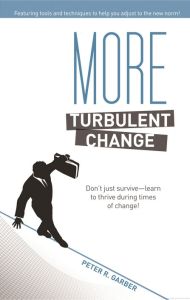Join getAbstract to access the summary!

Join getAbstract to access the summary!
Peter R. Garber
More Turbulent Change
Don't Just Survive – Learn to Thrive During Times of Change!
ASTD Publications, 2012
What's inside?
This manual can help you cope with stressful changes in your workplace.
Recommendation
Employees must deal with change, including turnover among their leaders and peers, potential mergers and acquisitions, competition, shifting economic conditions, and more. Human resources professional Peter R. Garber provides coping strategies for managing work and life transitions, and offers tips for discussing change initiatives with your employees. Garber doesn’t waste words, and his useful advice applies to both your professional and personal lives. getAbstract recommends Garber’s approach to managers who must communicate with their workers about upgrades, upsets and upheavals, and to the workers affected by them.
Summary
About the Author
Peter R. Garber, author of more than 50 books, is a human resources manager for PPG Industries, a manufacturing company based in Pittsburgh.
















Comment on this summary